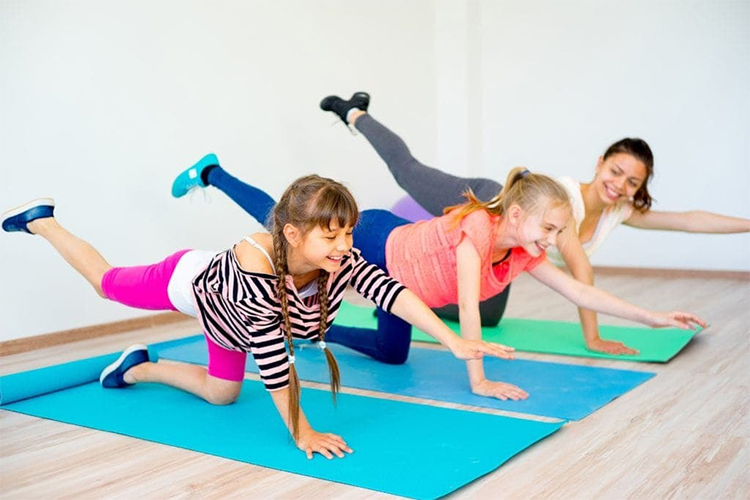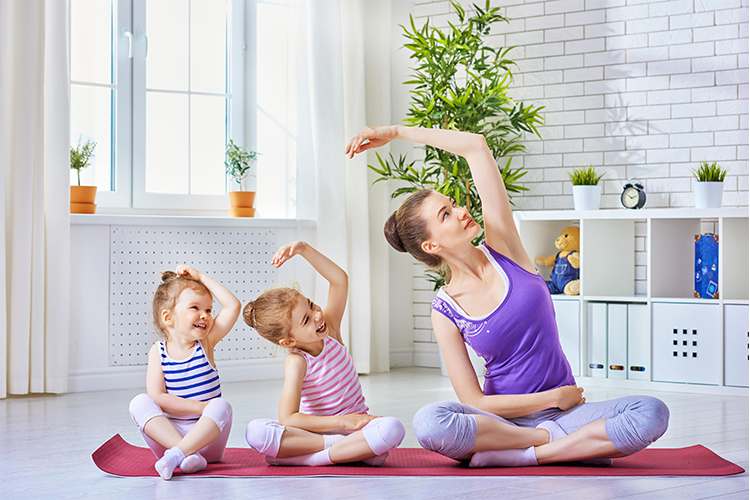Yoga isn’t just for adults; it’s a practice that can offer significant benefits for children too. Introducing children to yoga at a young age can help them develop a strong foundation of both physical fitness and emotional well-being. With its combination of movement, breathwork and mindfulness, yoga is a great way for children to learn how to relax, focus and strengthen their bodies in a fun and engaging way.
In today’s fast-paced world where children often face stressors from school, social pressures and technology, incorporating yoga into their daily routine can help them better control their emotions, improve their concentration and boost their self-esteem. The playful nature of yoga for kids also encourages creativity, collaboration and self-expression, making it a valuable tool for promoting both physical and mental development.
This guide to yoga for kids explores the benefits of this practice as well as how to incorporate it into their lives in a fun and accessible way. While children may not always understand the deeper spiritual aspects of yoga, the physical benefits and mindfulness elements can be transformative at any age.

Why Yoga for Kids?
Yoga offers children the opportunity to develop not only physical strength and flexibility, but also emotional resilience. As children engage in various poses, they develop a sense of discipline and focus. The breathing exercises that accompany yoga are especially helpful in teaching children how to calm themselves in moments of stress or anxiety. These simple tools of self-regulation are invaluable as children navigate the challenges of growing up.
Yoga also promotes mindfulness, which means being present in the moment without judgment. For children, this means learning to focus their attention, let go of distractions, and engage with the world around them in a thoughtful and conscious way.
Additionally, yoga can serve as a creative outlet. Many children enjoy the playful side of yoga, as they imitate animals, try different poses, and combine movement with imagination. For example, you can do Downward Dog or Cat-Cow poses, which not only improve flexibility but also stimulate children’s imagination in a fun and educational way.
Benefits of Yoga for Kids
The physical benefits of yoga for kids are numerous. Regular practice helps build strength, flexibility and coordination as children learn to contract and stretch different muscle groups. Yoga can also improve posture and body awareness, both of which are crucial during the growth stages of childhood.
In addition to the physical benefits, yoga helps children develop emotional intelligence. It promotes feelings of relaxation and calm, which can help reduce stress and improve mood. For children who struggle with anxiety or frustration, yoga’s deep breathing exercises and mindfulness techniques can be a valuable tool for self-soothing and regulating their emotions.
Yoga is also a wonderful way to improve social skills. When practiced in a group or class, children learn to collaborate, share and take turns. Many poses require joining with other children or forming a shape together, which encourages teamwork and communication.
The benefits of yoga for children go beyond the mind and body. Yoga promotes an understanding of balance—both literally and figuratively. Practicing holding poses and balancing in different ways strengthens the mind and body and teaches children the importance of patience, perseverance and focus. These qualities are important not only for yoga, but for life as a whole.

How to Make Yoga Fun for Kids
The key to getting kids excited about yoga is to make the practice fun and accessible. Rather than just focusing on the traditional poses and routines that adults practice, kids’ yoga should be playful and full of imagination.
One effective way to get kids excited about yoga is to create an atmosphere of storytelling. Incorporate animals, nature, and other familiar elements that children can relate to into their yoga practice. For example, when teaching Downward Dog Pose, you can tell children they are imitating a dog stretching after a long nap, or when doing Tree Pose, you can encourage them to pretend they are large trees swaying gently in the wind.
Another way to capture children’s attention is through the use of music and props. Incorporating music that is calming or stimulating depending on the mood of the session can help create a fun atmosphere. Props such as yoga mats, scarves, or stuffed animals can be used to make the practice more interactive and add a creative and hands-on element that will stimulate children’s imaginations.
Yoga for children should also be dynamic and varied. Rather than focusing on long sequences, shorter sessions with a variety of poses will keep children interested and excited. Incorporate breathing exercises, simple meditation, and mindfulness activities to help children explore different aspects of yoga. As they become more comfortable with the practice, they will naturally focus more on their movements and bodies, creating a positive cycle of growth and development.
How to Start Yoga for Kids at Home
Starting yoga for kids at home doesn’t have to be complicated and doesn’t require any special equipment. All you need is a calm, quiet space with enough room to move. Start by teaching your child a few basic poses and make the experience fun. You can start with simple poses like cat-cow, child’s pose, or downward dog, all of which are easy for children to understand and provide a great introduction to yoga.

When guiding your child through yoga, keep the instructions clear and simple. It’s important to provide plenty of encouragement and avoid making it feel like a strict class. Let your child explore the poses at their own pace and focus on having fun rather than perfection.
A regular routine helps children develop a sense of discipline and consistency. Taking time to practice yoga together every day or a few times a week can produce positive results over time. You can keep the exercises short—10 to 20 minutes is ideal for younger children.
You might also consider incorporating yoga into your daily activities. For example, you can encourage your child to practice mindful breathing before a stressful situation, such as a school exam or before bed. Over time, they will learn to associate yoga with feelings of calm and relaxation.
Conclusion
Yoga for kids is an incredibly valuable practice that benefits both the body and the mind. By introducing children to yoga, you give them the tools to develop strength, flexibility, and balance, while also teaching them important life skills like mindfulness, emotional regulation, and cooperation.
When approached with creativity and fun, yoga can be an engaging and fun activity for children. Whether at home or in class, the goal should be to foster a sense of joy and connection with the body and mind. Practicing yoga can help children build resilience, cultivate self-confidence, and improve their overall health – all while having fun. ate.
As children develop their yoga practice, they will carry these skills over to other areas of their lives, learning to manage stress, stay focused, and tackle challenges with patience and confidence. Yoga isn’t just an activity—it’s a lifelong skill that children can benefit from for years to come. So roll out the mats, get creative, and watch your child experience the many positive benefits yoga has to offer.





